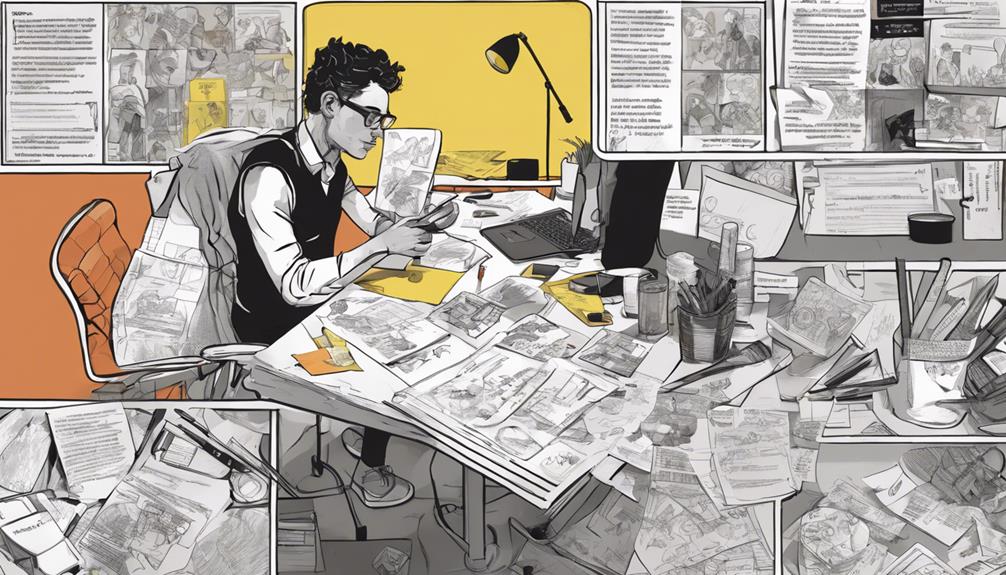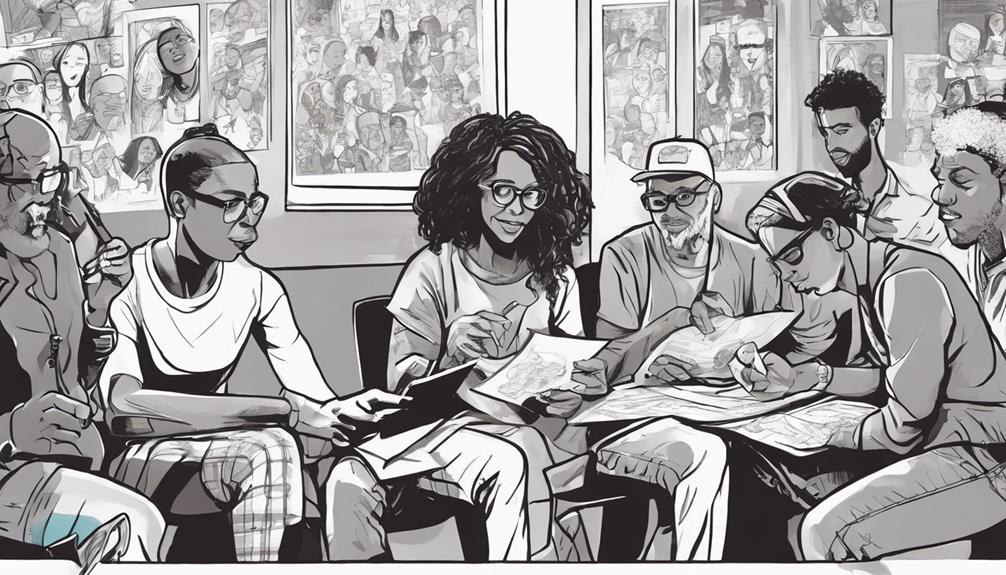Creating a persona in the design thinking process helps you uncover profound insights into user needs and behaviors, guiding you towards crafting user-centered design solutions with accuracy and empathy. By developing detailed profiles based on real user research, you gain a clearer comprehension of your target audience, enabling you to make informed design decisions that resonate with users on a personal level. This approach fosters innovation and guarantees that your products are not only functional but also deeply user-focused. Embrace the power of design thinking personas to elevate your design process to new heights!
Key Takeaways
- Guides design decisions with user insights.
- Fosters empathy for user needs.
- Predicts user behavior effectively.
- Enhances design solutions' personalization.
- Drives innovation through user-centric approach.
Importance of Design Thinking Personas
Design thinking personas play a crucial role in guiding design decisions and fostering a user-centric approach to innovation. By creating user personas grounded in actual empathy and understanding, the design thinking process gains profound insights into the needs and behaviors of the target audience.
These personas, crafted through thorough UX research, ensure a user-centered design approach that prioritizes customer needs effectively. Through persona creation, designers develop a deep understanding of the users, allowing for better decision-making and feature prioritization.
These personas help manage design conflicts, anticipate user expectations, and streamline the design process by providing actionable insights. By incorporating personas in the design thinking process, teams can work cohesively towards solutions that meet user needs and expectations, ultimately driving successful innovation and product development.
Steps for Persona Development

You should follow a structured approach in creating personas by defining a clear problem statement and conducting thorough user research.
Analyzing and synthesizing the collected data will help you identify key insights for developing realistic personas.
Remember to validate and refine your personas with real users to guarantee their accuracy and effectiveness in guiding the design process.
Persona Creation Process
To develop personas effectively in the design thinking process, the first step involves defining a clear problem statement to guide the persona creation journey. Once you have identified the problem, move on to conducting thorough user research. This step allows you to gather essential data on demographics, behaviors, and motivations, providing a solid foundation for persona development.
Next, analyze and synthesize the collected data to extract valuable insights that will shape the creation of realistic personas. By understanding user needs, behaviors, and pain points, you can cultivate empathy and design solutions that truly resonate with your target audience.
Lastly, create detailed personas that encapsulate demographic information, user behavior patterns, and pain points. These personas play an important role in guiding the design process by ensuring that your solutions are tailored to meet the specific needs of your users.
Remember to validate and refine these personas through user feedback to guarantee their accuracy and effectiveness in driving your design decisions.
Persona Validation Importance
Validating personas is a critical step in the design thinking process, ensuring that your design solutions are grounded in accurate user representations and insights. To achieve this, engage users in real-world interactions to test personas, refine them based on feedback, and update them with new insights. Cross-referencing personas with market segments and persona attributes helps align design decisions with user needs effectively.
| Importance of Persona Validation | ||
|---|---|---|
| Engage Users | Refine Personas | Update Personas |
| Actively involve real users to gain valuable feedback. | Continuously adjust personas based on insights gathered. | Enhance persona effectiveness by integrating new information. |
Enhancing Design Solutions

Enhancing design solutions is crucial for guaranteeing user-centricity and effectiveness in addressing diverse user needs and behaviors. By leveraging personas in the design process, you can tailor your solutions to cater to specific user types and behaviors effectively.
Here's how personas can improve your design solutions:
- Personalization: Design solutions informed by personas allow for a customized approach, resonating with different user types and their unique behavioral flows.
- Empathy: Personas humanize users, helping you sympathize with their needs and motivations, leading to more user-centric design decisions.
- Prediction: Utilizing personas enables you to forecast user behavior accurately, guiding you to create comprehensive design solutions that anticipate and address user needs proactively.
Incorporating personas into your design process not only adds depth and complexity but also guarantees that your design solutions aren't just visually appealing but also functional and user-focused.
Validation and Refinement

Validate and refine your personas through engaging with real users and stakeholders for feedback.
Testing personas in real-world scenarios is essential to maintain accuracy.
Remember to update and adjust personas based on new insights to guarantee they align with problem statements and value propositions.
Persona Accuracy Validation
To guarantee the accuracy and effectiveness of personas in the design thinking process, it's important to validate and refine market segments and persona attributes based on real user feedback and interactions.
Here are some key actions to confirm persona accuracy:
- Engage with Real Users: Actively involve real users, stakeholders, or domain experts in the persona development process. Their insights and feedback are vital for refining personas to accurately represent the target audience.
- Constant Testing: Regularly test personas in real-world scenarios to assess their accuracy and reliability. This continuous testing helps identify areas for improvement and ensures that personas remain effective.
- Cross-Reference with Problem Statements and Value Propositions: Align personas with problem statements and value propositions to maintain consistency and relevance. By cross-referencing personas with these key elements, you can confirm that they address the right issues and provide value to the users.
Iterative Persona Refinement
Begin by consistently improving and updating personas through iterative validation to confirm their accuracy and relevance in the design thinking process. Engaging stakeholders and real users is vital in gathering feedback for refining personas effectively. By testing personas with real-world interactions, you confirm that they remain accurate and reliable guides for design decisions. It's vital to update personas based on new insights to enhance their effectiveness continuously.
Improving personas involves cross-referencing them with problem statements and value propositions to align them with the design goals. This iterative persona improvement process ensures that your personas accurately represent the target audience, leading to more informed design decisions.
Regularly gathering feedback and incorporating it into persona updates helps in maintaining their relevance and usefulness throughout the design thinking process.
Utilizing Personas in Decision Making

Utilizing personas in decision-making processes provides a structured approach for prioritizing user needs and aligning design solutions with diverse user behaviors. By incorporating personas into your decision-making strategies, you can:
- Balance Human Perspectives with Business Goals:
Personas help you ensure that design decisions cater to user needs while also aligning with the overarching business objectives, resulting in user-centric outcomes that benefit both the users and the business.
- Anticipate User Expectations:
Personas assist in predicting user expectations, enabling you to proactively address user needs and preferences in your design solutions, thereby creating products that resonate with your target audience.
- Foster Creativity in Decision-Making:
Building Products With Users in Mind

Incorporating detailed persona descriptions into your product development process secures a user-centered approach that prioritizes user needs and motivations. Conducting user research and understanding your customers are fundamental steps in building products with users in mind.
By creating user personas that include demographics, behaviors, and motivations, you can secure a user-focused UX design process. Defining the problem and utilizing persona templates help in accurately representing your target audience.
Empathy maps can further enhance your understanding of your customers, enabling you to design products that cater to their specific needs. Collaborating with creative teams and iterating on persona descriptions based on user research feedback allows for refining personas to better align with user expectations.
Creating Design Thinking Personas

Crafting design thinking personas involves synthesizing demographic, psychographic, and behavioral data to create a detailed profile of the ideal customer. These personas are pivotal in the design thinking process as they help in understanding user needs deeply.
By creating personas, you can:
- Understand Needs: Through user interviews and data points, you can uncover insights that aid in empathizing with your target audience, ensuring your design solutions resonate with them.
- Enhance Decision-Making: Design thinking personas provide a clear picture of your users, enabling you to make informed decisions that align with their preferences and behaviors.
- Fuel Creative Process: By using personas as a guide, product designers can explore brainstorming sessions with a user-centric approach, sparking innovative ideas that cater to specific user requirements.
Incorporating design thinking personas into your process won't only streamline your UX efforts but also foster a more user-centered and effective design approach.
Understanding User Behavior Prediction

Personas play an important role in predicting user behavior by capturing key traits, motivations, and pain points of specific user segments. By creating a persona, you gain valuable insights into user behavior prediction, which is vital in developing user-centered solutions.
Understanding user segments helps in aligning design components with user goals, ensuring that your design solutions address the pain points of the target audience effectively. Anticipating user expectations through personas guides you in crafting design solutions that resonate with users, leading to more impactful outcomes.
Predicting user behavior with personas enables you to streamline the design process by focusing on features that cater to diverse user groups. This proactive approach eliminates the need for extensive usability testing while ensuring that resources are efficiently allocated to prioritize functionalities that align with user expectations.
Utilizing personas in user behavior prediction empowers design teams to create solutions that not only meet user needs but also exceed them, ultimately enhancing the overall user experience.
Design Refinement With Personas

Utilizing personas in design refinement ensures a targeted approach to meeting user needs and behaviors efficiently. By incorporating personas into the design process, you can guarantee that your design solutions are tailored to address the specific requirements of your target users effectively.
Here's how personas aid in design refinement:
- User-Centric Design Solutions:
Personas help in aligning design components with user goals, making sure that the final product focuses on impactful functionalities that cater to user preferences.
- Understanding User Behavior:
By anticipating user expectations and behaviors through personas, you can streamline the design process and create solutions that resonate with diverse user groups and behavioral flows.
- Holistic Solutions for User Pain Points:
Design refinement with personas enables the creation of holistic solutions that accurately address user pain points, leading to a more user-centric and efficient design outcome.
Frequently Asked Questions
How Creating a Persona Helps in the Design Thinking Process?
Creating a persona helps in the design thinking process by humanizing users, understanding their needs, and tailoring design solutions. It guides you in predicting behavior, offering diverse perspectives, and ensuring empathetic, user-centered solutions.
Why Are Personas Important in Design?
Personas are essential in design as they bring users to life, fostering empathy and guiding tailored solutions. They guarantee diverse user needs are met and provide fresh perspectives, aiding in thorough design solutions.
What Is Persona Mapping in Design Thinking?
Persona mapping in design thinking involves creating detailed profiles of fictional but realistic users based on research data. It helps you empathize with users, prioritize features, and guarantee design solutions align with user needs.
What Is the Persona Creation Process?
You create personas by defining user segments, synthesizing data, and validating them with real users for accurate design guidance. They're essential for predicting behavior, overcoming design challenges, and crafting tailored solutions effectively.
Conclusion
Now that you know how creating a persona can enhance the design thinking process, you may be thinking it's too time-consuming.
But remember, taking the time to understand your users and their needs will ultimately save you time in the long run by creating more effective and user-centered solutions.
So don't skip this essential step in your design process – your users will thank you for it!









